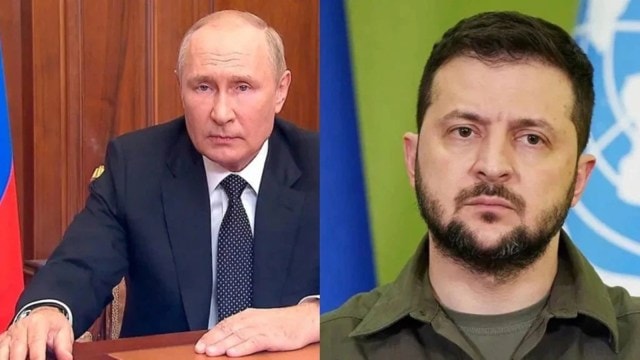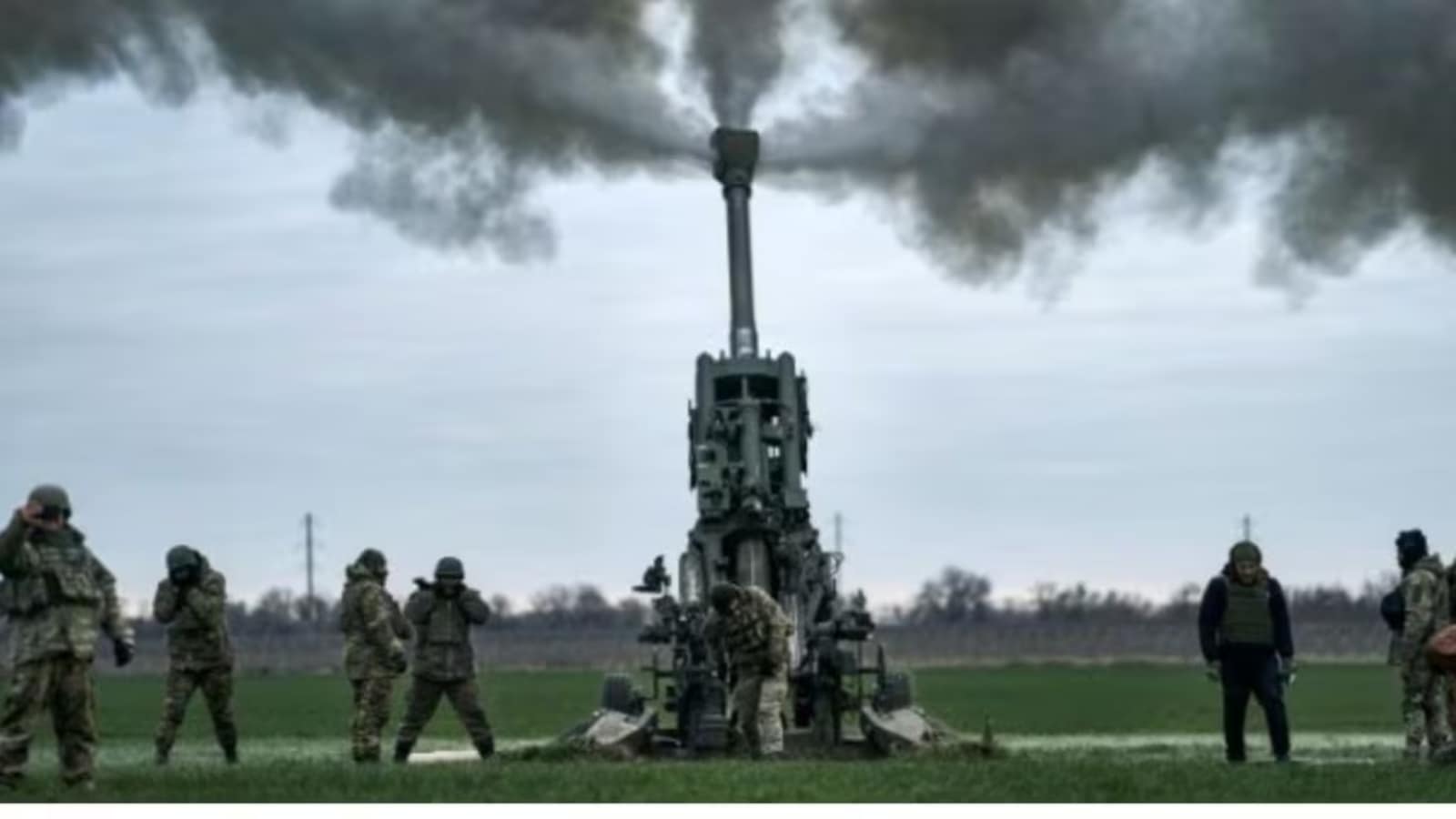Stay updated with the latest - Click here to follow us on Instagram
Russification of Ukrainian children amid invasion sparks war crime allegations
As Russian forces invaded Kherson, Ukraine, in February 2022, staff at Kherson Children’s Home struggled to protect vulnerable children.
 Putin is ready to halt the war in Ukraine with a negotiated ceasefire that recognises the current battlefield lines. (Express File Image)
Putin is ready to halt the war in Ukraine with a negotiated ceasefire that recognises the current battlefield lines. (Express File Image)As news of Russia’s invasion spread through Ukraine on Feb. 24, 2022, Dr. Natalia Lukina was waiting for a taxi at her home.
It was 6 a.m. and she was eager to get to work at Kherson Children’s Home, a state-run foster home for institutionalized children with special needs, where she served as a doctor.
By the time she arrived, the rumble of artillery fired by Russian troops advancing on Kherson City, the region’s capital, was already reverberating through the hallways. The doctor and her fellow caregivers faced a wrenching problem: how to protect the dozens of vulnerable children.
They were all infants and toddlers, and some had serious disabilities, such as cerebral palsy. Some had living parents who retained limited custody over them, while others had been removed from troubled homes or abandoned.
“Who else would have stayed behind to look after them?” Lukina said about her decision to remain with the children. “Imagine if we all turned our backs and left?”
Olena Korniyenko, director of the foster home and the children’s legal guardian, had prepared emergency bags for the children two weeks earlier, and she had stocked the home with boxes of food, water and diapers.
But the building was not equipped to withstand gunfire or shelling, and police had already fled the city.
Korniyenko searched online for a map of nearby bomb shelters and found one within walking distance.
Amid exchanges of fire, the staff carried the children and their mattresses by foot and stroller to a concrete basement, taking with them food, medicine, electric pumps and feeding tubes for the sickest children.
A local pastor got word of their plight later that day and urged the foster home staff to take the children to his church.
So, the staff moved the children again, sweeping them into hiding in the basement of Holhofa Church.
One nurse, Kateryna Sydorchuk, said they were afraid that Russian forces would take the children away.
And their fears soon came true: On April 25, 2022, Russian officials found the children and took them under their own authority, eventually moving them 180 miles from home.
Evidence shows the transfer was part of the broader, systematic campaign by Russian President Vladimir Putin and his political allies to strip the most vulnerable victims of the war of their Ukrainian identity.
The New York Times reviewed Russian social media posts; obtained photos, videos, text messages and documents; and interviewed more than 110 caregivers, legal experts, and Russian and Ukrainian officials to trace the lives and movement of the children as they were taken into Russian custody.
What happened to them next, legal experts say, may amount to a war crime.
 Russia claimed Sunday that it had taken control of the village of Umanske in the partially Russian-occupied Donetsk region. (AP/File Photo)
Russia claimed Sunday that it had taken control of the village of Umanske in the partially Russian-occupied Donetsk region. (AP/File Photo)
Two weeks into the invasion
Russia’s commissioner for children’s rights, Maria Lvova-Belova, sat across from Putin in a televised meeting to ask for his help.
She wanted to resettle young Ukrainian children from child-care facilities caught in the crossfire of war. He promised to remove any legal “red tape” so they could be placed permanently with Russian families.
For weeks, Ukrainian officials and police officers had struggled to find a way to evacuate the children from Holhofa Church, which was by then occupied territory.
In April, a Ukrainian commissioner made a plea on Telegram to help rescue them.
Hours later, armed men led by a Russian official who called himself Navigator showed up at the church and demanded that the children be returned to Kherson Children’s Home. Cameras from a Crimea-based propaganda outlet filmed their arrival, and the resulting story accused the Ukrainian authorities of kidnapping the children.
The pastor protested, claiming the children were safer in his basement. But the caregivers had little choice but to obey the orders and take the children back to the foster home in Kherson City, where occupation forces had a tighter grip.
By the spring of 2022, the occupation of Kherson had become a template for the forced assimilation of a Ukrainian city and its residents: A new occupation government was appointed in Kherson, and a Russian flag was raised outside the foster home.
For the next several months, Russian officials documented their efforts to help the children on their popular channels on Telegram.
Navigator, the man who had ordered the children removed from the church, visited the foster home repeatedly. He would later be identified as Igor Kastyukevich, a Russian member of parliament from Putin’s political party, United Russia.
That May, Putin fulfilled his promise to Lvova-Belova by issuing a presidential decree that eased citizenship requirements: In Kherson and other occupied regions, Ukrainian caregivers could now file for Russian citizenship on behalf of Ukrainian foster children and orphans.
The decree also expedited the process so that children could become Russian citizens in 90 days or less.
The next month, Korniyenko was summoned to Kherson’s Ministry of Health, now run by the occupation authorities. A Russian-backed official asked her to remain the director, but under his supervision.
But Korniyenko refused. Lukina resigned, too.
In search of a new director, the occupation authorities turned to Dr. Tetiana Zavalska, a pediatrician at the foster home. She was sympathetic to the new occupation administration and made clear her pro-Russian views.
Zavalska encouraged the occupation authorities to formally register the foster home.
It was registered that month.
That August, the Russian state-run television network RT ran a segment celebrating Kherson’s occupation that featured the foster home, now a legal entity in their eyes.
As Putin illegally annexed Kherson and three other regions, Ukrainian forces began a military campaign to retake Kherson City.
Russian officials came up with a plan for the children in the foster home. In a private online chat for medical students, health officials in Russian-occupied Crimea recruited volunteers to help move them.
Natalia Kibkalo, a nurse, had just put nearly a dozen children to bed, all sick with COVID-19, when she heard the news: The children would be removed in the morning.
The next morning, on Oct. 21, she changed diapers and fed the children. But she couldn’t stand the thought of helping to send them away and took a taxi home.
Around 8 a.m., ambulances and white buses arrived at the foster home.
The group included Kastyukevich, aka Navigator, as well as the Crimean health minister at the time, his deputy, the student volunteers and several administrators from another foster home who would eventually become the children’s new caregivers.
Zavalska gathered the children’s personal legal documents and medical records.
Outside the home, Kastyukevich held one child in his arms and kissed him before passing him on as, one by one, the names of the 46 children were called out. Then they were carried onto the waiting buses and ambulances.
The convoy left the foster home later that morning. By evening, they arrived at their destination.
At least one set of parents said they learned their children were in Crimea only when Times journalists visited them in Kherson six months later — even though documents showed that Russian officials had their names and address.
Their children, Mykola, who had autism, and Anastasiya Volodin, who had cerebral palsy, were placed in state custody years ago after the couple was deemed unable to care for them. Ukrainian courts had yet to decide on their parental rights.
“I won’t allow anybody to adopt them,” said their father, Roman Volodin.
In the winter of 2022
the new caregivers, along with Zavislaks, the appointed legal guardian, took steps to formally integrate the children in Russian society, even though some of them had birth parents in Ukraine who still had legal rights or who were known to Russian authorities.
First, the caregivers applied for Russian birth certificates for the children and translated their names into Russian.
The caregivers arranged for the children to get Russian social security numbers, saying it was a requirement for the children to receive medical care.
The new documents were inadvertently revealed in a Telegram post by Russian-appointed officials.
Eventually, the children received Russian citizenship, the final step necessary to make them eligible for adoption and permanent placement with Russian families.
Legal experts said the new documents revealed an intent by Russian authorities to strip the children of their Ukrainian identity, in violation of the Convention on the Rights of the Child. It may also amount to a war crime.
The anniversary of the war brought presidential state awards from Putin to the two Crimean officials who helped orchestrate the transfer of the children from Kherson.
But the very next day, the chief prosecutor at the International Criminal Court issued arrest warrants for Putin and his children’s rights commissioner, accusing them of “unlawfully” taking “at least hundreds of children” from children’s homes across Ukraine.
Seven of the children from Kherson Children’s Home have returned to Ukraine with the assistance of Ukrainian authorities and third-party Qatari mediators. They included Anastasiya and Mykola Volodin, whose mother traveled in February to Moscow to claim them.
Anastasiya later died in a Ukrainian hospital just weeks after her sixth birthday. A doctor attributed her death to an epileptic seizure. Ukrainian authorities have resumed care of Mykola while a court determines whether his parents can be his legal guardians.
For now, the rest of the children from Kherson remain in Russian custody.



- 01
- 02
- 03
- 04
- 05




























